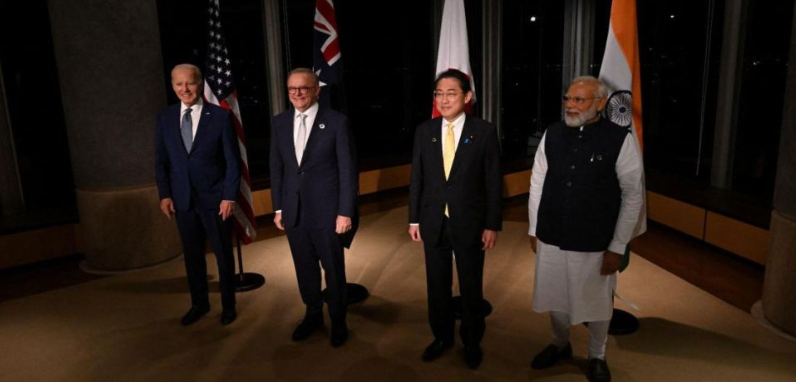Quad Reaffirms Commitment to a Free and Stable Indo-Pacific (GS Paper 2, IR)

Context
- The Quad countries—India, the United States, Australia, and Japan—have renewed their commitment to a free, open, and stable Indo-Pacific region through a joint statement marking 20 years of their cooperation.
- This reaffirmation highlights the group’s increasing role in shaping the security and prosperity of the Indo-Pacific.
Key Points from the Joint Statement
- Support for ASEAN Centrality: The Quad reiterated its strong backing for the centrality of the Association of Southeast Asian Nations (ASEAN) in the regional security framework. The group pledged to work in concert with ASEAN to strengthen regional cooperation and stability.
- Implementation of ASEAN Outlook on the Indo-Pacific (AOIP): The members endorsed the ASEAN Outlook on the Indo-Pacific as a guiding framework for cooperative efforts in the region, emphasizing the importance of inclusive, region-wide collaboration.
- Humanitarian Assistance and Disaster Relief (HADR): A significant focus of the Quad’s efforts in 2024 was enhancing disaster preparedness and delivering rapid humanitarian aid during crises across the Indo-Pacific region. This underscores the group's commitment to addressing human security challenges in the region.
Origins and Strategic Significance of the Quad
- The Quadrilateral Security Dialogue (Quad) began as an informal partnership in the aftermath of the 2004 Indian Ocean tsunami when the four nations joined forces for humanitarian assistance and disaster relief.
- The initiative was formalized in 2007 by Japan's then-Prime Minister Shinzo Abe but faded in subsequent years.
- In 2017, the Quad was revived, marking a shift in the regional geopolitical landscape, particularly in response to China’s growing influence in the region.
- The Quad’s strategic importance lies in its ability to promote a rules-based order in the Indo-Pacific and counterbalance China’s expanding dominance.
- For India, it offers an opportunity to strengthen maritime security, safeguard vital trade routes, and assert its position as a regional power in East Asia.
Challenges Facing the Quad
Despite its growing influence, the Quad faces several challenges:
- Diverging National Interests: Each member state brings unique geopolitical and economic priorities to the table, which sometimes leads to disagreements on specific issues such as military cooperation, trade policies, or climate action.
- Perceptions of Anti-China Intent: The Quad’s efforts to counter China’s influence can lead to tensions with other countries in the Indo-Pacific that maintain strong economic ties with Beijing.
- Lack of a Formal Structure: The Quad’s informal nature and absence of a secretariat limit its ability to develop long-term strategic initiatives and coordinated actions.
- ASEAN’s Concerns: Some ASEAN countries have voiced concerns that the Quad’s growing influence could undermine their centrality in regional security dynamics.
The Road Ahead for the Quad
- India will host the next Quad Summit in 2025, a significant opportunity to consolidate the group's vision for a secure, inclusive, and prosperous Indo-Pacific.
- Moving forward, the Quad must address concerns about being perceived as an anti-China bloc and work towards promoting regional acceptance of its goals.
- Future cooperation could focus on key areas such as emerging technologies, infrastructure development, climate resilience, and capacity building, helping to broaden the Quad’s engagement in the region beyond security concerns.
- By strengthening these partnerships and ensuring transparent communication, the Quad can enhance its role in shaping the Indo-Pacific’s future while fostering greater regional cooperation and stability.


